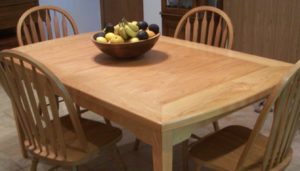How to care for timber furniture
October 21, 2013
Timber has been the furniture building material of choice since the beginning of civilization. This is no surprise in that wood is durable, easily worked and outside a very few locales, readily available. Another aspect that makes it such an awesome furniture component is that barring fire, flood or runaway bulldozers, it is all but impossible to make a piece of quality wooden furniture completely unusable. Because of this ruggedness, caring for timber furniture requires only the most cursory efforts in most cases. Outside truly monumental disasters, there are only a few enemies that timber furniture has, and avoiding them requires only a little thought.
The first and probably most immediate danger to timber furniture is the family pet. Bored dogs chew things. In lieu of a better option, a cat will be perfectly content sharpening its claws on an expensive piece of timber furniture. The choices to protect timber furniture from animals are keeping them apart or training the animals to avoid damaging the furniture. Fortunately, even if there is a mistake in this endeavor, the damage done will be minor if caught quickly.
The second and more insidious danger to timber furniture is extreme humidity change. Much of the intrinsic strength of wood is due to the slight amount of moisture retained in the cells of the timber that allows those cells to retain suppleness. Bone dry wood becomes very brittle and can crack and break far more easily. There are two considerations to protecting timber from drying too completely. First, keeping the furniture out of direct sunlight is a good idea. Prolonged exposure to the hot sun will dry out anything that contains moisture. A good rule of thumb for judging how much sunlight is too much is imagining sitting in that spot. If the spot is too sunny for a person to sit there for a short time, it’s almost certainly too sunny for a piece of furniture to sit there for years.
The second protection from over drying is ensuring that the finish remains intact. Aside from being a beautifying aspect, the finish on a piece of timber seals it to make it more difficult to lose moisture.
Far too much moisture can also destroy timber furniture. Fortunately, ambient humidity is not really a danger. The most common place such damage occurs to furniture is during storage or shipping. To protect the furniture during these periods, cover it to protect from drips and put something under it to raise it off the floor to protect it from water that could flow in from any leak.
Given just a few logical precautions, quality timber furniture will remain useful and beautiful for generations.
